An Unknown Proclamation Medal of Valladolid de Michoacán: Carlos III (1761)
by Ricardo Vargas
Continuing my research on the proclamation medals of my beloved Michoacán, I stopped again in the city of Valladolid, today called Morelia, to investigate the oath to Fernando VI in 1747 and the ones to Carlos III in 1760 and 1761. The stories of the oaths to the kings are truly interesting, colorful, detailed and full of symbolism and, when it comes to numismatics, there are always small details that generate great revelations.
Before delving into the oaths of Fernando VI and Carlos III, I must mention that I was able to find evidence and documentation of acts of proclamation in Valladolid since Felipe IV in 1621 through Carlos II Morelia Municipal Historical Archive (AHMM), Manuscript Books, No. 2 (1616-1729), fs. 127-130v in 1666, Felipe V in 1701 and Luis I in 1724. All of those acts took place even when Pátzcuaro held the capital of the province of Michoacán. Valladolid had to wait for Pátzcuaro to hold its festivities first to be able to carry out the proclamation and with ceremonies of much smaller magnitude than those that took place in the lake city. For none of those proclamation acts did I find evidence of any medals made for the oath.
Since the beginning of the 18th century, to be precise in 1701, Valladolid and Pátzcuaro began a legal and propaganda war The propaganda war was reflected in the Gazetas de México No. 60, 79 and 80, an information medium for all of New Spain trying to be recognized as the capital of Michoacán. Although Pátzcuaro Henry Soto, Fiestas Reales y ontificias en Pátzcuaro, CREFAL, Pátzcuaro, Mexico., 1991, p. 16 won the battle with regard to the swearing-in of Felipe V and Luis I, it would end up losing the war since Valladolid would definitively be crowned as the capital of Michoacán after the oath to Fernando VI.
The Oath to Carlos III
After the death of Fernando VI, his half-brother, Carlos III, came to the Spanish throne, and the news quickly spread throughout the empire. In Valladolid Carlos III was sworn to twice; once on 24 November 1760, and the other almost a month and a half later, on 12 January 1761. For both swearing-in, proclamation medals were made, both of them cast, a technique widely explained by my very good friend Alejandro M. Bustos, in different conferences and in his article “Brief review of the cast medals (and locals) Issued in the Colonial Mexico that celebrated the kings of Spain and the Indies” Bustos, Alejandro M., “Brief review of the cast medals (and locals) issued in the Colonial Mexico that celebrated the kings of Spain and the Indies” USMEXNA Journal, December 2021, pp. 8-16. published in this journal in December 2021.
There are two Valladolid medals for Carlos III listed by the most important authors on the subject. The first, from 1760, cataloged by Grove: K62, Medina: 121, Herrera: 105 and Betts: 503, was last sold in January 2015 by Heritage (Lot 1031), for $10,575 USD.
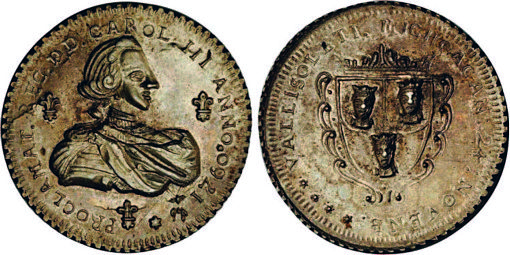
Valladolid 1760 Cast Silver – Grove K62
This specimen, in addition to being the only known, was in César Hernández collection. It is in an excellent state of preservation and with unsurpassed quality in its casting and brushing, with complete legends and without any wear. This medal is the one ordered by the Valladolid City Council for the swearing-in ceremony that took place on 24 November 1760.
OBVERSE: The armed bust of Carlos III looking to the right, wearing the Order of the Golden Fleece surrounded by the legend, whose reading begins at 6:00 o’clock in a clockwise direction: * PROCLAMAT. REG. D D. CAROL. III. ANNO. 1760. The year is in the opposite direction to the reading. Between the legend and the bust we have three fl eurs-de-lis flanking it at 3, 6 and 9 o’clock.
REVERSE: In the center, the shield of Valladolid in its most minimal version, the heads of three kings within a crowned shield. Surrounding it, the phrase: VALLISOLETI. MICHOACAN: 24 NOVENB. * * * *
Fortunately, I was able to locate a very important document from 1760 in the Municipal Historical Archive of Morelia: Actas de Cabildo #28, a book in which is recorded the “Proclamación y jura Carlos III en Valladolid de Michoacan“. This book recounts everything from the preparations to the expenses, highlighting at all times the central figure of the swearing-in, alderman Miguel Antonio de Pagola, Provincial Mayor of the Holy Brotherhood, who served as Ensign carrying the royal flag and in charge of the swearing-in Morelia Municipal Historical Archive. Cabildo Minutes Book, No. 28: p. 28-34.
Miguel de Mafra Bargas, royal scribe, recounts the moment in which the medals were thrown to the people and briefly mentions that the pieces were carved for that purpose and describes them:
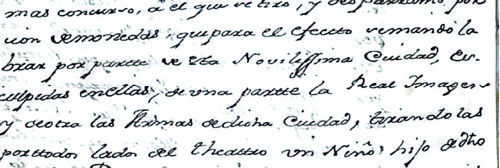 “... and scattered a portion of coins that for this purpose was ordered to be carved by the
“... and scattered a portion of coins that for this purpose was ordered to be carved by the
Most Noble City, sculpted on them, on one side the Royal Image and on the other the
Arms of said City...ibid.
The fact that the medals were described made them undoubtedly a central part of the celebration: however, for us numismatists, we find something truly valuable on page 58 of this book, since in it we meet Francisco Rivera, who was the silversmith who was commissioned to make the dies and cast the medals , which would be equivalent to the engraver for the case of the medals minted at the Academy of San Carlos, as was Gerónimo Antonio Gil for the medals of Carlos IV , and Francisco Gordillo for those of Fernando VII.
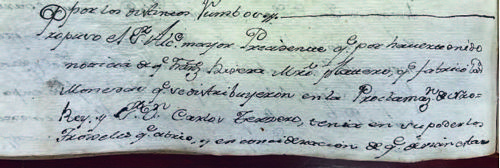 “... for having obtained news that Francisco Rivera Master silversmith who made the coins
“... for having obtained news that Francisco Rivera Master silversmith who made the coins
that were distributed in the Proclamation of Our King and Lord Don Carlos the Third, had
in his possession the dies that he opened...”
To give us an idea of the importance of this piece of information (the identity of the master silversmith), of the little more than 90 cast proclamation medals that are known to date, I have not found in any other city and for any other king any reference that provides the name of the local silversmith or engraver who made the medals.
The exception that we could try to fit in is on the medals of the oath of Carlos IV of Guadalajara elaborated by Antonio Forcada y la Plaza, one of the best silversmiths of New Spain and chief assayer. These medals, although of local manufacture, do not correspond to the type of cast medals, since they were minted and subsequently punched with the crowned GA mint and with the engraver’s surname: FORCADA.
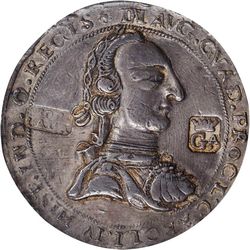
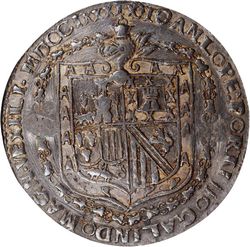
C-61 Silver Proclamation Medal (Stack’s Bowers ANA Auction -20 August 2021, lot 41161)
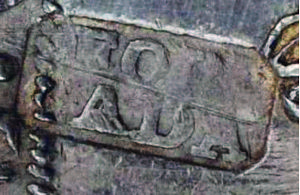
Detail of the mark FORCADA
In a strict sense, Forcada is not a local character, nor a town silversmith, since he was named marker of the Caja Real and chief assayer of the Mint: “For the silversmiths those charges represented the most important authority” Anderson, Lawrence, El Arte de la Platería en México, Porrúa, Mexico., 1956, p. 301
The second oath to Carlos III
Not satisfied only with the oath made in November 1760, the people of Valladolid celebrated the monarch again on 12 January 1761, as stated in the pamphlet published on 21 April 1761, by Juan José Moreno Pizano: Real proclamación a nuestro invicto monarca el señor D. Carlos III (que Dios guarde), que celebró en el día doce de henero de 1761, D. Joseph María de Lyra Sánchez Bustamante y Tagle, Arteta y Berganza, Sámano y Medinilla; en la ciudad de Valladolid cabeza de la Provincia de Michoacán, a document printed in Mexico City by the Oldest College of S. Ildefonso Other pamphlets and prints of the time referring to the Jura of Carlos III in Valladolid, cited in the Biblioteca Hispano Americana Septentrional de José Mariano Beristain de Sosa (1816) are:
1. Agustín Castro, El Nuevo Ulises: Poema de la proclamación de Carlos III en Valladolid de Michoacán, printed in Mexico City, 1762.
2. Relación Histórica de la solemne Proclamación del señor D. Carlos III, Rey de España y de las Indias, hecha en Valladolid de Michoacán por el Alférez Real D. José de Lira printed in Mexico City, 1761.
3. “Relación de las fiestas de la Ciudad de Valladolid de Michoacán en la Jura de Carlos III de España printed in Mexico City, 1761.
.
During said oath, organized by the Ecclesiastical Council, coins were also delivered to the public. They had been previously documented by Grove: K-63, Medina: 122, Herrera: 106 and Betts: 504, all of them mentioning the size of 28 millimeters in cast silver. Despite having been cataloged by all of them, it is only in Grove’s book that we find a drawing of the piece:
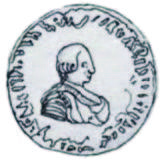
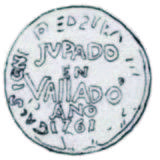
Grove illustration: K-63.
Betts, in the supplementBenjamin Betts, Supplement to some undescribed Spanish-American Proclamation Pieces. American Journal of Numismatics, Vol. 34 No. 2. , 1899, pp. 39-44 that he published to his book Some Undescribed Spanish-American Proclamation Pieces, adds this piece, asserting that it has no corded edge and that it belonged to George Friederich Ulex, a collection that was sold at auction in 1908 in Frankfurt Münzen und Medaillen verschiedener Länder: Sammlung eines süddeutschen Antiquitäten-Händlers; Reformations-Münzen und - Medaillen, Sammlung eines sächsischen Freiherrn; Münzen und Medaillen aus verschiedenem Besitz zum Theil aus dem Nachlasse eines preussischen Prinzen; numismatic Bücher; Versteigerung: 29. Oktober und folgende Tage. (1902) (Bd. 1902.10.29). Frankfurt, M.: Hess. The lot number 1700 represents the first and only time this medal has been offered for public auction.

Excerpt from the auction catalog of the Ulex collection
From this catalog we can discover that its weight is 6.5 grams and it clarifies that no other specimen is known. Unfortunately, in the six pages of plates presented for this auction, this particular medal was not photographed.
Last year, while reviewing some old inventories, I found that in the Mexican Mint, known today as the National Numismatic Museum, there was a piece from Valladolid 1761. I immediately requested the images and thanks to the support and efforts of Ricardo Vázquez, they sent them to me. To my surprise (and everyone’s, I think) when I received the images, I noticed that the obverse of the piece is totally different from the drawing presented by Grove, and much more similar to the designs used in Mexico for Fernando VI, as in the case of the piece F6-3 that I presented earlier. The specimen is described as cast bronze; however, I think it is cast silver with a deep ocher patina. It is pierced at 12:00 o’clock and has notable wear.
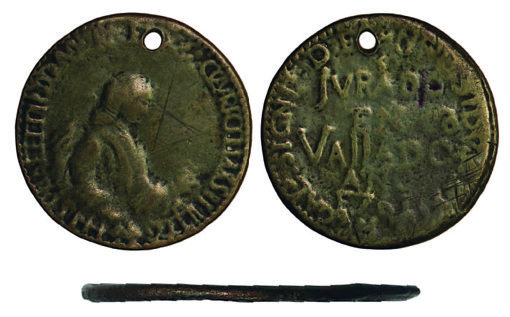
Proclamation Medal for Carlos III in Valladolid Michoacán 1761
(Image provided by the Museo Numismático Nacional de la Casa de Moneda de México)
I could not say that Grove’s drawing is mistaken: however, after reviewing the reverse and seeing that most of the elements are identical, including the same missing areas on the coin, it seems unlikely that two diff erent obverses were made. It would be very important to find the Ulex specimen and have the full panorama since I do not think that this medal is the same specimen from that collection; the description of the piece in the auction catalog does not state that it had a hole.
To the best of my ability I will try to describe the obverse and reverse of this extraordinary piece, whose photograph appears for the first time, to the delight of all numismatists and historians.
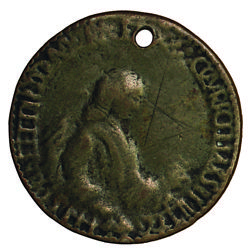 OBVERSE: In the center we can see half the body of Carlos III designed in the style of the medals of Fernando VI, where you can see his two hands, wig and coat dress.
OBVERSE: In the center we can see half the body of Carlos III designed in the style of the medals of Fernando VI, where you can see his two hands, wig and coat dress.
On the periphery, the legend that begins to read at 1:00 clockwise seems to say: CAROLUS III DG HISPAN ET INDIAM REX.
The legend is double and in some places it is more difficult to read than in others.
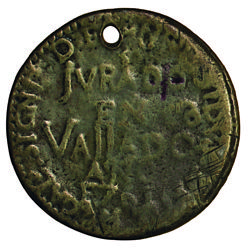 REVERSE: In the center is the legend in five lines: JURADO / EN LA / VALLADO. / AÑO / DE 761. Note that the word DE is monogrammed and that the number “1” does not appear in the date.
REVERSE: In the center is the legend in five lines: JURADO / EN LA / VALLADO. / AÑO / DE 761. Note that the word DE is monogrammed and that the number “1” does not appear in the date.
On the periphery another legend is outlined that runs around the entire perimeter of the coin, it can barely be read: ….UE …..SIDV…. REGAL. SIGNIT. DE. All the descriptions of the books present this incomplete legend, I think that in this copy we can appreciate more letters than have has been previously described.
With this article I conclude my investigation of the proclamation medals of Valladolid prior to Ferdinand VII, surprised to have found data on a new medal in honor of Ferdinand VI and happy to have been able to locate a piece of Carlos III, of which until now we did not have photographs and that, probably, may even be a variant of the previously catalogued one. Finding the specimen from the Ulex collection would greatly help to clarify the doubts as to whether it is a new piece or a known error in the drawing. In any case, finding two new specimens of Proclamation Medals for Michoacán in the twenty-first century, is an invitation for other numismatists to do more research.
I would like to thank my numismatic friend Jaime Alberto Vargas Chávez and Melba Maya Guz for all their support with the visit and digitization of the manuscript books of the colonial collection of the Historical Archive of the Municipality of Morelia.
